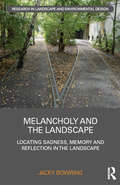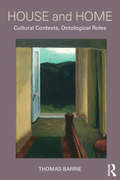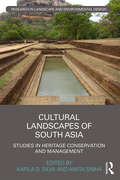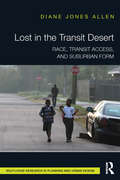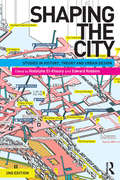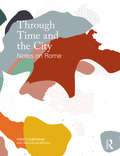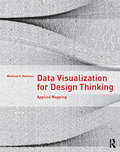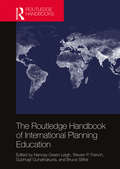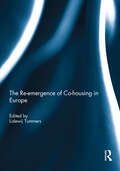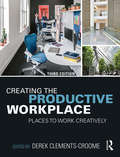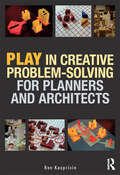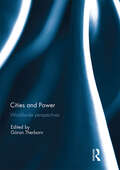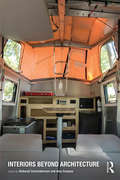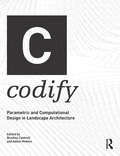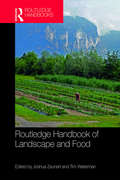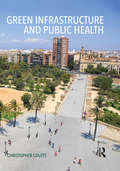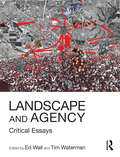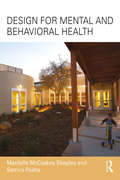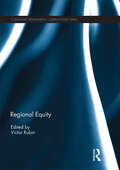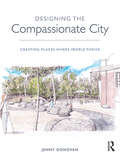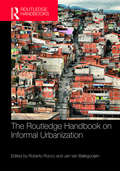- Table View
- List View
Melancholy and the Landscape: Locating Sadness, Memory and Reflection in the Landscape (Routledge Research in Landscape and Environmental Design)
by Jacky BowringWritten as an advocacy of melancholy’s value as part of landscape experience, this book situates the concept within landscape’s aesthetic traditions, and reveals how it is a critical part of ethics and empathy. With a history that extends back to ancient times, melancholy has hovered at the edges of the appreciation of landscape, including the aesthetic exertions of the eighteenth-century. Implicated in the more formal categories of the Sublime and the Picturesque, melancholy captures the subtle condition of beautiful sadness. The book proposes a range of conditions which are conducive to melancholy, and presents examples from each, including: The Void, The Uncanny, Silence, Shadows and Darkness, Aura, Liminality, Fragments, Leavings, Submersion, Weathering and Patina.
House and Home: Cultural Contexts, Ontological Roles
by Thomas BarrieHouse and home are words routinely used to describe where and how one lives. This book challenges predominant definitions and argues that domesticity fundamentally satisfies the human need to create and inhabit a defined place in the world. Consequently, house and home have performed numerous cultural and ontological roles, and have been assiduously represented in scripture, literature, art, and philosophy. This book presents how the search for home in an unpredictable world led people to create myths about the origins of architecture, houses for their gods, and house tombs for eternal life. Turning to more recent topics, it discusses how writers often used simple huts as a means to address the essentials of existence; modernist architects envisioned the capacity of house and home to improve society; and the suburban house was positioned as a superior setting for culture and family. Throughout the book, house and home are critically examined to illustrate the perennial role and capacity of architecture to articulate the human condition, position it more meaningfully in the world, and assist in our collective homecoming.
Cultural Landscapes of South Asia: Studies in Heritage Conservation and Management (Routledge Research in Landscape and Environmental Design)
by Kapila D. Silva Amita SinhaWinner of the Environmental Design Research Association's 2018 Achievement Award The pluralism of South Asia belies any singular reading of its heritage. In spite of this diversity, its cultural traditions retain certain attributes that are at their core South Asian—in their capacity to self‐organize, enact and reinvent cultural memories, and in their ability to retain an intimate connection with nature and landscape. This volume focuses on the notion of cultural landscape as a medium integrating multiple forms of heritage and points to a new paradigm for conservation practices in the South Asian context. Even though the construct of cultural landscape has been accepted as a category of heritage, its potent use in heritage management in general and within the South Asian context in particular has not been widely studied. The volume challenges the prevalent views of heritage management in South Asia that are entrenched in colonial legacies and contemporary global policy frameworks.
Lost in the Transit Desert: Race, Transit Access, and Suburban Form
by Diane Jones AllenIncreased redevelopment, the dismantling of public housing, and increasing housing costs are forcing a shift in migration of lower income and transit dependent populations to the suburbs. These suburbs are often missing basic transportation, and strategies to address this are lacking. This absence of public transit creates barriers to viable employment and accessibility to cultural networks, and plays a role in increasing social inequality. This book investigates how housing and transport policy have played their role in creating these "Transit Deserts," and what impact race has upon those likely to be affected. Diane Jones Allen uses research from New Orleans, Baltimore, and Chicago to explore the forces at work in these situations, as well as proposing potential solutions. Mapping, interviews, photographs, and narratives all come together to highlight the inequities and challenges in Transit Deserts, where a lack of access can make all journeys, such as to jobs, stores, or relatives, much more difficult. Alternatives to public transit abound, from traditional methods such as biking and carpooling to more culturally specific tactics, and are examined comprehensively. This is valuable reading for students and researchers interested in transport planning, urban planning, city infrastructure, and transport geography.
Shaping the City: Studies in History, Theory and Urban Design
by Rodolphe El-Khoury Edward RobbinsTaking on the key issues in urban design, Shaping the City examines the critical ideas that have driven these themes and debates through a study of particular cities at important periods in their development. As well as retaining crucial discussions about cities such as Los Angeles, Atlanta, Chicago, Detroit, Philadelphia, and Brasilia at particular moments in their history that exemplified the problems and themes at hand like the mega-city, the post-colonial city and New Urbanism, in this new edition the editors have introduced new case studies critical to any study of contemporary urbanism – China, Dubai, Tijuana and the wider issues of informal cities in the Global South. The book serves as both a textbook for classes in urban design, planning and theory and is also attractive to the increasing interest in urbanism by scholars in other fields. Shaping the City provides an essential overview of the range and variety of urbanisms and urban issues that are critical to an understanding of contemporary urbanism.
Through Time and the City: Notes on Rome
by Kristi Cheramie Antonella De MichelisThrough Time and the City: Notes on Rome offers a new approach to exploring cities. Using Rome as a guide, the book follows familiar sites, geographies, and characters in search of their role within a larger narrative that includes the environmental processes required to generate enough space and material for the city, the emergent ecologies to which its buildings play host, and the social patterns its various structures help to organize. Through Time and the City argues that Rome is made and unmade by an endlessly evolving chorus that has, for better or worse, gained geological legitimacy; that the city absorbs and emits countless artifacts in its search for collective identity; that the city is a platform for the constant staging of negotiations between agents (humans, buildings, plants, animals, pathogens, goods, waste, water) that drive and are driven by the entanglements of climate and culture. This book provides textual and visual frameworks for identifying the material traces, emergent patterns, or speculated futures that expose a city as inseparable from its capacity to change.
Data Visualization for Design Thinking: Applied Mapping
by Winifred E. NewmanData Visualization for Design Thinking helps you make better maps. Treating maps as applied research, you’ll be able to understand how to map sites, places, ideas, and projects, revealing the complex relationships between what you represent, your thinking, the technology you use, the culture you belong to, and your aesthetic practices. More than 100 examples illustrated with over 200 color images show you how to visualize data through mapping. Includes five in-depth cases studies and numerous examples throughout.
The Routledge Handbook of International Planning Education
by Subhrajit Guhathakurta Nancey Green Leigh Steven P. French Bruce StiftelThe Routledge Handbook of International Planning Education is the first comprehensive handbook with a unique focus on planning education. Comparing approaches to the delivery of planning education by three major planning education accreditation bodies in the United States, Australia, and the United Kingdom, and reflecting concerns from other national planning systems, this handbook will help to meet the strong interest and need for understanding how planning education is developed and delivered in different international contexts. The handbook is divided into five major sections, including coverage of general planning knowledge, planning skills, traditional and emerging planning specializations, and pedagogy. An international cohort of contributors covers each subject’s role in educating planners, its theory and methods, key literature contributions, and course design. Higher education’s response to globalization has included growth in planning educational exchanges across international boundaries; The Routledge Handbook of International Planning Education is an essential resource for planners and planning educators, informing the dialogue on the mobility of planners educated under different national schema.
The re-emergence of co-housing in Europe
by Lidewij TummersAcross Europe, the number of co-housing initiatives is growing, and they are increasingly receiving attention from administrators and professionals who hold high expectations for urban liveability. Is co-housing a marginal idealist phenomenon, or the urban middle class’ answer to the current housing crisis? And has the development of theoretical insight and research kept up with the actual expansion of co-housing as a practice? These questions were raised during the first European conference on co-housing research, which took place in Tours, France, in March 2012. Both the conference and this book aim to move beyond case-studies, and to look more particularly at the implications and wider perspective of the current co-housing trend.Using the specific vocabulary of different disciplines and geographic regions, the contributions to this book analyse the underlying thinking behind, and the expectations projected on, diverse models of collaborative housing. The authors are aware of the qualities of contemporary co-housing, but they go beyond advocacy to investigate the conditions under which co-housing can be successful as a strategy for housing provision; can offer solutions for sustainable urban development; or indeed can contribute to involuntary or intentional gentrification. This book was originally published as a special issue of the Journal of Urban Research and Practice.
Creating the Productive Workplace: Places to Work Creatively
by Derek Clements-CroomeThe built environment affects our physical, mental and social well-being. Here renowned professionals from practice and academia explore the evidence from basic research as well as case studies to test this belief. They show that many elements in the built environment contribute to establishing a milieu which helps people to be healthier and have the energy to concentrate while being free to be creative. The health and well-being agenda pervades society in many different ways but we spend much of our lives in buildings, so they have an important role to play within this total picture. This demands us to embrace change and think beyond the conventional wisdom while retaining our respect for it. Creating the Productive Workplace shows how we need to balance the needs of people and the ever-increasing enabling technologies but also to take advantage of the healing powers of Nature and let them be part of environmental design. This book aims to lead to more human-centred ways of designing the built environment with deeper meaning and achieve healthier and more creative, as well as more productive places to work.
Play in Creative Problem-solving for Planners and Architects
by Ron KasprisinIn Play in Creative Problem-solving for Planners and Architects, "play" is defined, explored and demonstrated as a critical catalyst in creative problem-solving processes. The book defines the current psychological research into play and creative problem-solving, explores the necessary integration of the two, and exemplifies for students and practitioners the use of play in creative endeavors; and the role that play serves in separating linear from creative problem-solving approaches. Play is explored regarding its elements (tools, skills, environment), characteristics (a free activity without failure) and attitude as it relates to and activates the creative process with the focus on urban design, planning, architecture, and landscape architecture. The book re-establishes the whole mind-body thinking process of play as a means of object-learning; to provide designers and planners with alternative ways of design-thinking; and to challenge the over-utilization of digital technologies in creative processes. Creative problem-solving requires an appreciation for ambiguity, uncertainty of outcome, complexity that leads to the discovery of novelty and innovation. The book incorporates examples and exercises in play activities related to the design and planning fields, and exercises related to play-tools and skills for students and professionals. It also defines terms used in play and creativity psychology; provides examples and structure for play and creative problem-solving activities; describes the type and use of appropriate play-tools; contains an extensive bibliography on play and creative problem-solving texts; and provides significant illustrations making it fundamental reading for students and professionals in urban design and planning fields.
Cities and Power: Worldwide Perspectives
by Göran TherbornWhat do cities tell us about power? How does power shape cities? These are the main questions answered by a multidisciplinary set of eminent urban scholar in crisp articles on capital cities from around the world, from Buenos Aires to Tokyo, from Jakarta to Moscow. Focus is on contemporary cities and their manifestations and representations of power, though often with a historical grounding, and the collection also includes an example of archaeological urban analysis, from northern Mesopotamia. Through its variety of approaches by leading scholars of the field, and its variety of cities with their different histories and their diverse national contexts and political organization the book gives a uniquely insightful and easily accessible world overview of cities of power.This book was published as a special issue of the International Journal of Urban Sciences.
Interiors Beyond Architecture
by Deborah Schneiderman Amy CamposInteriors Beyond Architecture proposes an expanded impact for interior design that transcends the inside of buildings,?analysing significant interiors that engage space outside of the disciplinary boundaries of architecture. It presents contemporary case studies from a historically nuanced and theoretically informed perspective, presenting a series of often-radical propositions about the nature of the interior itself. Internationally renowned contributors from the UK, USA and New Zealand present ten typologically specific chapters including: Interiors Formed with Nature, Adaptively Reused Structures, Mobile Interiors, Inhabitable art, Interiors for Display and On Display, Film Sets, Infrastructural Interiors, Interiors for Extreme Environments, Interior Landscapes, and Exterior Interiors.
Codify: Parametric and Computational Design in Landscape Architecture
by Bradley Cantrell Adam MekiesCodify: Parametric and Computational Design in Landscape Architecture provides a series of essays that explore what it means to use, modify and create computational tools in a contemporary design environment. Landscape architecture has a long history of innovation in the areas of computation and media, particularly in how the discipline represents, analyses, and constructs complex systems. This curated volume spans academic and professional projects to form a snapshot of digital practices that aim to show how computation is a tool that goes beyond methods of representation and media. The book is organized in four sections; syntax, perception, employ, and prospective. The essays are written by leading academics and professionals and the sections examine the role of computational tools in landscape architecture through case studies, historical accounts, theoretical arguments, and nascent propositions.
Routledge Handbook of Landscape and Food
by Tim Waterman Joshua ZeunertSince the turn of the millennium, there has been a burgeoning interest in, and literature of, both landscape studies and food studies. Landscape describes places as relationships and processes. Landscapes create people’s identities and guide their actions and their preferences, while at the same time are shaped by the actions and forces of people. Food, as currency, medium, and sustenance, is a fundamental part of those landscape relationships. This volume brings together over fifty contributors from around the world in forty profoundly interdisciplinary chapters. Chapter authors represent an astonishing range of disciplines, from agronomy, anthropology, archaeology, conservation, countryside management, cultural studies, ecology, ethics, geography, heritage studies, landscape architecture, landscape management and planning, literature, urban design and architecture. Both food studies and landscape studies defy comprehension from the perspective of a single discipline, and thus such a range is both necessary and enriching. The Routledge Handbook of Landscape and Food is intended as a first port of call for scholars and researchers seeking to undertake new work at the many intersections of landscape and food. Each chapter provides an authoritative overview, a broad range of pertinent readings and references, and seeks to identify areas where new research is needed—though these may also be identified in the many fertile areas in which subjects and chapters overlap within the book.
Green Infrastructure and Public Health
by Christopher CouttsThere is a growing body of knowledge revealing a sweeping array of connections between public health and green infrastructure – but not until now have the links between them been brought together in one comprehensive book. Green Infrastructure and Public Health provides an overview of current research and theories of the ecological relationships and mechanisms by which the environment influences human health and health behaviour. Covering a broad spectrum of contemporary understanding, Coutts outlines: public health models that explicitly promote the importance of the environment to health ways in which the quality of the landscape is tied to health challenges of maintaining viable landscapes amidst a rapidly changing global environment This book presents the case for fundamental human dependence on the natural environment and creates a bridge between contemporary science on the structure and form of a healthy landscape and the myriad ways that a healthy landscape supports healthy human beings. It presents ideal reading for students and practitioners of landscape architecture, urban design, planning, and health studies.
Landscape and Agency: Critical Essays
by Tim Waterman Ed WallLandscape and Agency explores how landscape, as an idea, a visual medium and a design practice, is organized, appropriated and framed in the transformation of places, from the local to the global. It highlights how the development of the idea of agency in landscape theory and practice can fundamentally change our engagement with future landscapes. Including a wide range of international contributions, each illustrated chapter investigates the many ways in which the relationship between the ideas and practices of landscape, and social and subjective formations and material processes, are invested with agency. They critically examine the role of landscape in processes of contemporary urban development, environmental debate and political agendas and explore how these relations can be analysed and rethought through a dialogue between theory and practice.
Design for Mental and Behavioral Health
by Mardelle McCuskey Shepley Samira PashaStudies confirm that the physical environment influences health outcomes, emotional state, preference, satisfaction and orientation, but very little research has focused on mental and behavioural health settings. This book summarizes design principles and design research for individuals who are intending to design new mental and behavioural health facilities and those wishing to evaluate the quality of their existing facilities. The authors discuss mental and behavioural health systems, design guidelines, design research and existing standards, and provide examples of best practice. As behavioural and mental health populations vary in their needs, the primary focus is limited to environments that support acute care, outpatient and emergency care, residential care, veterans, pediatric patients, and the treatment of chemical dependency.
Regional Equity (Community Development – Current Issues Series)
by Victor RubinRegional equity as a field of scholarship, as an arena of policy change, and as a social movement has grown, diversified, and matured in important ways over the past decade. The fruits of that growth and development can be seen in recent federal and state policies, in the practices of many regional planning organizations, and in the agendas and approaches of countless community-based organizations and issue advocacy groups.As the field has expanded, a growing number of researchers have been tracking these phenomena: explaining how and why concepts of metropolitan development are being reframed; documenting the efforts to shape policies and diversify leadership; assessing where and how equity and social justice concerns have been brought into regional planning for transportation, land use, housing, public finances, environmental quality, smart growth, sustainable development, public health and other issue areas. This volume brings together analyses and commentary by some of the leading scholarly observers these timely developments.This book was published as a special issue of Community Development.
Designing the Compassionate City: Creating Places Where People Thrive
by Jenny DonovanDesigning the Compassionate City outlines an approach to urban design that is centred on an explicit recognition of the inherent dignity of all people. It suggests that whether we thrive or decline—as individuals or as a community—is dependent on our ability to fulfil the full spectrum of our needs. This book considers how our surroundings help or hinder us from meeting these needs by influencing both what we can do and what we want to do; either inspiring us to lead healthy, fulfilled lives or consigning us to diminished lives tainted by ill health and unfulfilled potential. Designing the Compassionate City looks at how those who participate in designing towns and cities can collaborate with those who live in them to create places that help people to accumulate the life lessons, experiences and achievements, as well as forge the connections to meet their needs, to thrive and to fulfil their potential. The book explores a number of inspiring case studies that have sought to meet this challenge and examines what has worked and what hasn’t. From this, some conclusions are drawn about how we can all participate in creating places that leave a lasting legacy of empowerment and commitment to nurturing one another. It is essential reading for students and practitioners designing happier, healthier places.
The Routledge Handbook on Informal Urbanization
by Roberto Rocco Jan Van BallegooijenThe Routledge Handbook on Informal Urbanization investigates the mutual relationship between the struggle for political inclusion and processes of informal urbanization in different socio-political and cultural settings. It seeks a middle ground between two opposing perspectives on the political meaning of urban informality. The first, the ‘emancipatory perspective’, frames urban informality as a practice that fosters autonomy, entrepreneurship and social mobility. The other perspective, more critical, sees informality predominantly as a result of political exclusion, inequality, and poverty. Do we see urban informality as a fertile breeding ground for bottom-up democracy and more political participation? Or is urban informality indeed merely the result of a democratic deficit caused by governing autocratic elites and ineffective bureaucracies? This book displays a wide variety of political practices and narratives around these positions based on narratives conceived upon specific case cities. It investigates how processes of urbanization are politicized in countries in the Global South and in transition economies. The handbook explores 24 cities in the Global South, as well as examples from Eastern Europe and East Asia, with contributions written by a global group of scholars familiar with the cases (often local scholars working in the cities analyzed) who offer unique insight on how informal urbanization can be interpreted in different contexts. These contributions engage the extreme urban environments under scrutiny which are likely to be the new laboratories of 21st-century democracy. It is vital reading for scholars, practitioners, and activists engaged in informal urbanization.
Small-Scale Urban Greening: Creating Places of Health, Creativity, and Ecological Sustainability
by Angela LoderSmall-scale urban greening projects are changing the urban landscape, shifting our experience and understanding of greenspaces in our cities. This book argues that including power dynamics, symbolism, and aesthetics in our understanding of the human relationship to urban nature can help us create places that nurture ecological and human health and promote successful and equitable urban communities. Using an interdisciplinary approach to current research debates and new comparative case studies on community perceptions of these urban greening projects and policies, this book explores how small-scale urban greening projects can impact our sense of place, health, creativity, and concentration while also being part of a successful urban greening program. Arguing that wildness, emotion, and sense of place are key components of our human–nature relationship, this book will be of interest to designers, academics, and policy makers.
Construction Detailing for Landscape and Garden Design: Urban Water Features
by Paul HenseyFollowing on from the author’s previous book, Construction Detailing for Landscape and Garden Design: Surfaces, Steps and Margins, this book, Construction Detailing for Landscape and Garden Design: Urban Water Features, provides clear instruction for the construction of small to medium scale water features. With over 130 black and white CAD designs, Hensey provides guidance on a range of different water features such as drainage, water bowls and containers, walls and edges, structures and crossings, and rills, channels and cascades. This book offers technical references and a general knowledge of the basic principles, materials and techniques needed when engineering with water. This practical guide would be beneficial for garden designers and landscape architects seeking accessible and relatable materials for designing water features.
Urban Design: A Typology of Procedures and Products
by Jon LangUrban Design: A Typology of Procedures and Products, 2nd Edition provides a comprehensive and accessible introduction to urban design, defining the field and addressing the controversies and goals of urban design. Including over 50 updated international case studies, this new edition presents a three-dimensional model with which to categorize the processes and products involved: product type, paradigm type, and procedural type. The case studies not only illuminate the typology but provide information that designers can use as precedents in their own work. Uniquely, these case study projects are framed by the design paradigm employed, categorized by procedural type instead of instrumental or land use function. The categories used here are Total Urban Design, All-of-a-piece Urban Design, Plug-in Urban Design, and Piece-by-piece Urban Design. Written for both professionals and those encountering urban design in their day-to-day life, Urban Design is an essential introduction to the field and practice, considering the future direction of the field and what can be learned from the past.
Urban Design: A Typology of Procedures and Products
by Jon LangUrban Design: A Typology of Procedures and Products, 2nd Edition provides a comprehensive and accessible introduction to urban design, defining the field and addressing the controversies and goals of urban design. Including over 50 updated international case studies, this new edition presents a three-dimensional model with which to categorize the processes and products involved: product type, paradigm type, and procedural type. The case studies not only illuminate the typology but provide information that designers can use as precedents in their own work. Uniquely, these case study projects are framed by the design paradigm employed, categorized by procedural type instead of instrumental or land use function. The categories used here are Total Urban Design, All-of-a-piece Urban Design, Plug-in Urban Design, and Piece-by-piece Urban Design.Written for both professionals and those encountering urban design in their day-to-day life, Urban Design is an essential introduction to the field and practice, considering the future direction of the field and what can be learned from the past.
